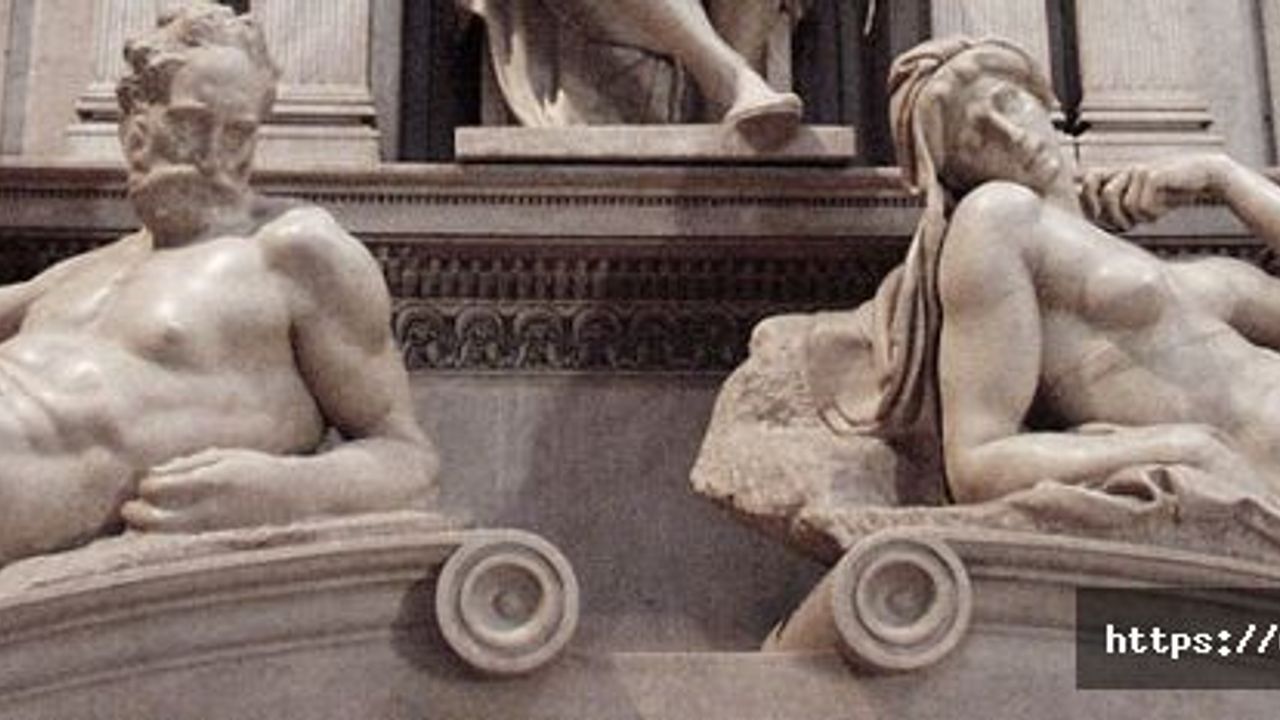Michelangelo Rönesans döneminde Floransanın önde gelen Medici Ailesinin özel bir isteği üzerine hangisini yapmıştır
Medici Şapelleri
ailesinin bazı üyeleri için mozoliteyi kurma arzusunu ifade eden: Lorenzo the Magnificent ve kardeşi Giuliano; Lorenzo, Urbino Dükü; ve Giuliano, Nemours Dükü. 1524'teki mimari çalışmaları tamamladıktan sonra Michelangelo, şapel duvarlarında yer alacak heykeller ve lahit üzerinde 1533 yılına kadar çalıştı. Gerçekte tamamlanmış olan sadece Lorenzo, Urbino Dükü heykelleri; Giuliano, Nemours Dükü; Gündüz ve Gece alegorilerinin dört şafağı, Şafak ve Alacakaranlık; Madonna ve Çocuk'u temsil eden grup; Her ikisi de Michelangelo'nun öğrencileri olan Montorsoli ve Baccio da Montelupo tarafından idam edilen Aziz Cosma ve Damian (Medici'nin koruyucuları) heykelleri tarafından kuşatılmıştır. Gerçekte tamamlanmış olan sadece Lorenzo, Urbino Dükü heykelleri; Giuliano, Nemours Dükü; Gündüz ve Gece alegorilerinin dört şafağı, Şafak ve Alacakaranlık; Madonna ve Çocuk'u temsil eden grup; Her ikisi de Michelangelo'nun öğrencileri olan Montorsoli ve Baccio da Montelupo tarafından idam edilen Aziz Cosma ve Damian (Medici'nin koruyucuları) heykelleri tarafından kuşatılmıştır. Gerçekte tamamlanmış olan sadece Lorenzo, Urbino Dükü heykelleri; Giuliano, Nemours Dükü; Gündüz ve Gece alegorilerinin dört şafağı, Şafak ve Alacakaranlık; Madonna ve Çocuk'u temsil eden grup; Her ikisi de Michelangelo'nun öğrencileri olan Montorsoli ve Baccio da Montelupo tarafından idam edilen Aziz Cosma ve Damian (Medici'nin koruyucuları) heykelleri tarafından kuşatılmıştır.
Mimari yapının ve Michelangelo'nun heykellerinin gücü, “aktif yaşam” ve “düşündüren yaşam” ın ölümden sonra Ruh'un kendi maneviyatına sıkı sıkıya bağlı bir felsefi kavram olan ruhun özgürleşmesiyle etkileştiği İnsan Yaşamının karmaşık bir sembolizmini yansıtıyor .
Michelangelo'nun birçok çizimi apsenin altındaki küçük bir alanda bulundu ve Sacristy'nin heykelleri ve mimarisiyle ilgili olabilir.
Prenslerin Şapeli
Bu Şapel, mimariyi yarı profesyonel bir şekilde uygulayan Giovanni de Medici'nin tasarımlarından sonra mimar Matteo Nigetti tarafından 1604 ve 1640 yılları arasında dikilmiş bir başka büyük ve çarpıcı türbedir. Büyük kubbesi ve mermerle süslü lüks iç mekanı ile Türbesi, birkaç yüzyıl boyunca Floransa'yı başarılı bir şekilde yöneten Medici hanedanının gücünü kutlamak için tasarlandı. Grand Dukes'in cesetlerini içermek için tasarlanmış sekizgen oda aslında neredeyse tamamen yarı değerli taşlar ve farklı renkli mermerler ile kaplıdır. Büyük Dükların lahitleri nişlerde bulunur ve bronz heykellerle tamamlanır. Yarı kıymetli taşların kakması,
Kubbenin iç yüzünün tamamen lapis lazuli ile kaplanması planlanmıştı, ancak Medici döneminin sonunda tamamlanmamıştı; Bugün gördüğümüz freskler, 1828 yılında Pietro Benvenuti tarafından boyanmış ve Eski ve Yeni Ahit sahnelerine sahipti; Bu freskler o zamanlar hüküm süren Lorraine ailesi tarafından görevlendirildi.
San Lorenzo Kilisesi
Of all the religious buildings in Florence, none is documented earlier than San Lorenzo. It was consecrated in 393 by St. Ambrose, Bishop of Milan, and acted as the city’s cathedral, before either the Baptistery or Santa Reparata. It was rebuilt in the romanesque period, and re-consecrated in 1059. In 1418 the Medici decided to rebuild it entirely, and entrusted the project to Filippo Brunelleschi, who in 1421 designed the ‘old’ sacristy and the whole church, completed by Antonio Manetti in 1461. In the next century Michelangelo Buonarroti was commissioned to build the New Sacristy and the Laurentian Library, and to design the façade (which was never built). Inside, the church is planned as a Latin Cross, its aisles separated from the nave by Corinthian columns surmounted by high sculpted entablature blocks, supporting rounded arches. The nave is covered by a coffered ceiling with gilded rosettes on a white ground. The slender elegance of Brunelleschi’s architectural forms, and the contrast of grey pietra serena and white plaster, make the interior of San Lorenzo one of the supreme architectural masterpieces of the Florentine Renaissance. The history of the church’s construction is closely linked to the patronage of the Medici family, who paid for most of the works of art inside. The two bronze pulpits are great works of Donatello’s late manner (c. 1460; finished by his assistants Bertoldo and Bellano), achieving intense dramatic expressivity in the New Testament scenes executed by Donatello himself in ‘stiacciato’ low relief, particularly the Deposition. Extreme technical refinement is apparent in the beautiful marble Tabernacle of the Sacrament, now in the right aisle, by Desiderio da Settignano (c. 1460). Like the Medici, the Martelli also made their mark on San Lorenzo, and their chapel off the left transept has a panel of the Annunciation by Filippo Lippi (c. 1450). Minor painting of the 15th century is represented by the altarpieces in the left transept such as Raffaellino del Garbo’s Nativity with St. Julian and St. Francis, and St. Anthony Abbot enthroned between St. Laurence and St. Julian, from the workshop of Ghirlandaio. The altars in the side aisles mostly have 16th-century altarpieces, most notably Rosso Fiorentino’s mannerist Betrothal of the Virgin, painted in 1523. His contemporary Pontormo executed some lost frescoes in the choir. The enormous fresco of the Martyrdom of St. Laurence in the left aisle (1565-69) is by Pontormo’s pupil Bronzino. The basilica was completed by the Old Sacristy, commissioned by the Medici as their family mausoleum. Giovanni di Bicci de’ Medici entrusted the project to Filippo Brunelleschi, who between 1421 and 1426 built one of the most complex masterpieces of renaissance architecture. Dedicated to St. John the Evangelist, it is structured as a cube covered by a hemispherical umbrella dome divided by ribs. The chromatic interplay of grey stone and white plaster is heightened by the presence of painted stuccoes: the frieze with cherubim and seraphim, the roundels with the Evangelists on the walls and the ones in the spandrels of the dome with Scenes from the life of St. John the Evangelist, by Donatello, who was also responsible for the bronze doors with Saints, Martyrs, Apostles and Doctors of the Church. The frescoes in the small dome in the apse show the Sun and constellations as they appeared over Florence on the night of 4 July 1442. It is thought that this celestial map was executed by the eclectic painter and decorator Giuliano d’Arrigo, known as Pesello. The funerary monument to Piero and Giovanni de’ Medici, sons of Cosimo il Vecchio, was commissioned from Verrocchio in 1472 by Lorenzo the Magnificent and his brother Giuliano: one of the most sophisticated products of Laurentian artistic culture.
